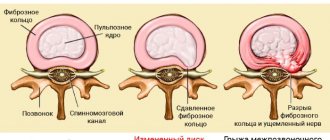Obsessive thoughts (obsessions) are images or impulses that invade consciousness uncontrollably, against a person’s will. Attempts to get rid of these thoughts lead to outbreaks of anxiety and bring severe discomfort. A person experiences constant fears and bad thoughts. If you do not seek help in time, obsessions lead to psychological exhaustion, social withdrawal and depression.
Obsessive thoughts occur in many diseases: neuroses, depression, obsessive-compulsive disorder (obsessive neurosis) and even schizophrenia.
Features that distinguish obsessive thoughts syndrome:
- a person cannot influence the appearance of such thoughts, thoughts arise against desire;
- obsessive thoughts are not connected with a person’s usual thoughts - they are separate, alien images;
- obsessive thoughts syndrome cannot be overcome by willpower;
- the disorder is associated with intense anxiety and irritability;
- clarity of consciousness and critical perception of one’s condition are usually preserved.
The disorder is extremely difficult to bear. Usually a person is aware of what obsessive thoughts mean, understands the irrationality of the images that arise in the head, but cannot fight them. Attempts to stop the appearance of thoughts and the coercive actions associated with them are unsuccessful and lead to even greater distress.
People who suffer from this disorder are not difficult to convince that their obsessive thoughts are unfounded. But this does not help get rid of the problem. Situations repeat themselves over and over again. A necessary step to getting rid of painful conditions is to seek help from a specialist before complications arise.
What is OCD?
Intrusive thoughts are persistent, unwanted thoughts about a specific topic. Obsessive actions (compulsions) are repeated physical or mental actions that the patient considers himself obligated to perform. Patients diagnosed with obsessive-compulsive disorder (OCD) often act out their obsessions.
For example, a person may constantly worry that his house will be robbed. To cope with anxiety, a person checks the locks on his doors ten times a night. These behaviors may not actually prevent a robbery or break-in, but the person experiences significant distress if they do not follow these steps.
These conditions usually appear around the age of 19, although in a quarter of cases the onset begins before the age of 14. OCD can affect people of all ages, social classes and ethnic groups.
OCD can last a lifetime if left untreated. Symptoms can interfere with work, relationships, and overall well-being. A psychotherapist can help patients get rid of symptoms and learn to cope with difficulties.
Obsessive ideation disease
Obsessive ideas are one of the subtypes of obsession. The disease of obsessive ideas is conventionally divided into subtypes, phobias relate to the intellectual and motor spheres, but often during obsession, obsessive thoughts combine, which becomes the cause of constant panic attacks.
Intrusive thoughts differ from ordinary anxiety in several characteristic ways:
- Anxiety arises at the subconscious level, involuntarily, while a person maintains adequacy and clarity of thought.
- The disorder is not related to thinking.
- Anxiety is not controlled by a person and cannot be eliminated by volitional effort.
- The disease is accompanied by a feeling of depression.
- The obsession does not affect the patient's intelligence.
- The patient fully understands that he has a mental disorder and is critical of his problem.
When a person ceases to be aware that the constant feeling of anxiety is caused by a mental disorder, obsessions develop into delusions. This complication occurs only in isolated cases, so it cannot be considered typical.
Most often, obsessive thoughts are of the nature of doubt, when a person is constantly lost in his actions, for example, when leaving home, he worries whether he turned off the gas or water, closed the door, or made the necessary entry. Almost always, the patient understands that his anxiety is unfounded, nevertheless, he checks his actions several times. It will not be difficult for an experienced psychologist at the Salvation clinic to convince a patient of the presence of a mental disorder that needs to be monitored and treated before the form of the obsession becomes more complicated.
OCD symptoms
OCD symptoms fall into two categories: obsessions and compulsions. Intrusive thoughts ( take the obsession test ) are recurring thoughts or urges that cause anxiety. These thoughts may be rooted in disgust, guilt, or fear. Obsessions often involve one of the following themes:
- Cleanliness: frequent thoughts about illness, dirt, etc. Patients overestimate the threat of contamination.
- Lack of order: Obsessions are often related to symmetry and completeness. The person may feel that something is out of order or “out of balance.” These are exaggerated perfectionistic tendencies and the need for control.
- Fear of harm. Often thoughts arise about accidents, injuries, etc. A person may be afraid of harming himself or loved ones. Patients may feel responsible for preventing tragedies by acting out their compulsive behaviors.
- Forbidden thoughts: This category includes intrusive thoughts about committing some taboo. For example, one person may be afraid of losing control and at the same time mentally swear during a business meeting. Another may imagine setting a building on fire, even though he doesn't want to do it.
Someone may have obsessions in multiple categories. Themes of obsession may change over time. When a person's obsessions are united by a religious theme, it is called religious OCD or obsession.
Obsessions can cause serious distress when they conflict with a person's ethics and character. However, such thoughts do not coincide with intention. A person with obsessive thoughts about hitting pedestrians is unlikely to commit murder. On the contrary, he is likely to be a more careful driver than the average person because the idea of harming others bothers him greatly.
How to deal with intrusive thoughts
Mental illnesses that underlie the syndrome in question are a reason to immediately consult a psychiatrist. Symptoms vary greatly, and it is not always easy to notice the distinctive features. Therefore, when asking what to do with obsessive thoughts, you need to contact an experienced specialist.
It happens that a person is afraid to ask for help or tries to independently find a way to cope with obsessive thoughts that are so annoying. One of the common solutions is the use of alcohol and drugs. If a person manages to be distracted, the illusion may briefly be created that the problem has disappeared. In fact, the situation is only getting worse. You should not try to “kill” obsessive thoughts in this way, because there is a possibility that in a state of alcoholic intoxication the obsessions will only intensify.
Talk to someone you trust, such as your parents or friends. A great option is to go to group therapy, in a community of people with similar problems. This will allow you to share experiences and receive support.
The consequences of drinking alcohol can be unpredictable. Even if there is a brief relief, the thoughts will still arise again, and with even greater force. As a result, new health problems are added, dependence on alcohol or drugs develops, and the disorder worsens. If you have a neurosis of obsessive thoughts, only a specialist can tell you how to get rid of or alleviate the condition.
In addition to the stages of treatment that the doctor will select for you, you need to remember about self-control, rehabilitation and prevention. Here are some tips in addition to basic treatment that will tell you how to deal with obsessive thoughts:
- Learn more about your disorder. Learning about your condition will help you quickly accept the problem, calm you down, and motivate you to better adhere to your treatment plan.
- Talk to someone you trust, such as your parents or friends. A great option is to go to group therapy, in a community of people with similar problems. This will allow you to share experiences and receive support.
- Normalization of lifestyle: adequate sleep, diet, avoidance of alcohol and potent psychotropic substances, moderate physical activity.
- Don't give up your normal activities. Build a career, study, devote time to your favorite hobby. Spend time with family and friends. Don't let your disease interfere with your life.
- Avoid stress: the idea that a strong surge of emotions will make the fight against obsessive thoughts more effective is false. You will be able to be distracted only for a short time, but then the nervous system will become even more vulnerable.
Compulsive symptoms in OCD
People with OCD often use compulsive behaviors ( take an OCD test ) to control their obsessions. For example, an anxious patient checks the smell of his breath. Some actions are taken to relieve stress (although there are more effective methods), others are aimed at preventing a dangerous event. A compulsive action does not necessarily have a logical connection with an obsession. For example, a child may count steps to prevent the death of a parent. However, if actions and thoughts are related, the action will be very disproportionate to the risk.
Obsessive-compulsive behavior is frequently and excessively repeated. It almost always interferes with everyday life. Some people feel forced to spend hours on their compulsive needs. Others may go out of their way to avoid certain triggers. Many people with OCD know that their behavior is not “logical”, but they still feel anxious and confused until they complete the necessary “ritual”.
Obsessive actions and thoughts: how to get rid of them?
ObsessionsOCDFearAnxiety
Obsessive thoughts or actions - also called obsessions and compulsions - are one of the most complex disorders. In addition to the actual time it takes to perform obsessive actions and “thinking” about obsessive thoughts, the person also experiences difficulties in communicating, working, studying, or in general in everyday life.
Minor obsessions or behaviors are familiar to everyone: we may be preoccupied with thoughts about an upcoming important event, such as an exam, we may worry about whether we have turned off the stove, we may avoid stepping on cracks in the pavement, and we may follow a certain routine every morning.
All this helps reduce anxiety and relieve tension. 40% of people feel irritated when they have to change the routine.
Some obsessive thoughts or ideas may even be useful in life.
Some time ago, I already published a list of obsessive thoughts that come to the minds of quite normal people, based on a survey on Facebook and according to data from the literature. Look at the picture: these are actions that many people intentionally perform (according to research by Muris, Murckelbanch & Clavan, 1997).
Here is a continuation of the list of obsessive thoughts in normal people.
However, in some cases, the frequency of intrusive thoughts becomes greater, and it becomes increasingly difficult to resist the impulse to perform a certain action.
Here is an example of how much obsessive-compulsive disorder can ruin and complicate the life of an ordinary person.
A case of obsessive thoughts about cheating
She worried more and more often that she would cheat on her husband. Maybe she even somehow unwittingly cheated on him?
A 26-year-old girl, let's call her S., dated a young man for a long time, finally he proposed to her and she agreed. Around this time, she first had a “strange” thought and anxiety that she might cheat on her future husband. Despite the fact that she did not have the slightest desire to do this, and she had never done this before, these fears were firmly lodged in her head, and, as the wedding day approached, S. became more and more worried , whether she will cheat on her husband. Maybe she even somehow unwittingly cheated on him? These thoughts caused her great discomfort; she could hardly escape from them.
Before this incident, S. periodically worried that she might harm other people: for example, when she bought a set of tableware, she thought that theoretically she might not be able to resist and unwittingly cut someone in her household with a knife, after which these thoughts began to constantly return to her. In general, S. considered herself a very polite and well-mannered girl with a gentle character, she had never had any problems with the law, and therefore these terrible thoughts frightened her very much.
In addition, S. felt guilty for having such thoughts. Therefore, she decided to take a number of measures for protection: for example, she removed the knives from the set and put them away in a cabinet with a lock; she avoided setting the table before dinner; she stopped leaving the house alone to completely eliminate the possibility that she would “impulsively” start flirting with other men.
After some time, she came up with the idea of starting to keep a special diary, where to write down where and with whom she was throughout the day from the moment she woke up until she went to bed, in this way S. could prove to herself that she had definitely not cheated on her husband and did not harm other people. She allowed herself not to keep a diary only if she was with her husband or with one close friend.
After some time, S. asked this close friend if she had heard any rumors that S. was cheating on her husband. A little later, S. began to be constantly interested in this topic, not only when communicating with a close friend, but also when communicating with other people.
And a little later, S. found herself carefully watching the news on TV in the hope that her name would not be mentioned in reports about crimes.
Her future husband could not help but notice this; he was very upset and saddened by what was happening. Of course, he was worried that S. was constantly talking and thinking about cheating on him. Also, these phenomena greatly interfered with S.’s own life, communication and work.
Features of obsessive thoughts and actions (obsessions and compulsions)
Is dust full of germs or not?
Compulsions, or obsessions , are far from just excessive worry about problems, and compulsions (obsessive actions) are not simple repetitive movements. The peculiarities of obsessions lie in the fact that a person perceives them as foreign, intruding, sometimes even contrary to his nature, excessive, senseless, but... they cannot do anything about them. Each time they return, the person experiences great anxiety.
Obsessions come in the form of:
- desires (the desire for the death of a spouse, for example);
- impulses (the impulse to swear in church);
- images (forbidden, unwanted images of scenes of a sexual or violent nature);
- ideas (microbes everywhere);
- doubts (closed or did not close the door).
Typically, obsessions contain one or more recurring themes, and the most common of these are contamination and dirt. Other “popular” obsessional themes are violence, aggression, neatness, symmetry, order, religion and sexuality. Typically, obsessive thoughts in normal people occur on exactly the same topics.
All people have strange thoughts about germs or an unlocked door, but some people think that this is not normal.
Separately, it is worth noting the obsessive feeling of “not good enough” (incompleteness). In this case, people may turn lights on and off several times or move objects from place to place until they feel that “now is good enough.” Unfortunately, “good enough” is becoming more and more difficult to achieve.
To get rid of obsessions, people suffering from obsessive-compulsive disorder feel an irresistible need to perform certain obsessive actions, or compulsions, also known as rituals . Despite the fact that a person understands “with his mind” that performing this action is irrational and pointless, he still performs it and feels relief. For a while. Compulsions can also take many forms, with the most common ones being cleansing, washing, checking, and organizing.
Other compulsions may be expressed in certain “defensive” words, counting, “special right thoughts,” prayers, and other attempts to neutralize or “cancel” the obsessive thought.
Obsessive thoughts and actions (rituals) are directly related to each other. Rituals allow you to reduce anxiety from an obsessive thought (or image, etc.). However, if, in essence, there is nothing dangerous in obsessive thoughts, then rituals are not so innocent.
We can say that the lion's share of the contribution to the maintenance of obsessive-compulsive disorder belongs to rituals. The second reinforcing and strengthening mechanism is avoidance : situations and events that can provoke obsessive thoughts or actions.
Other disorders similar to obsessive thoughts
It is necessary to distinguish obsessive-compulsive disorder from other conditions that are very similar to it, for example, trichotillomania, kleptomania, nail biting, tics, etc. For example, with trichotillomania (hair pulling), there are also repetitive and obsessive actions, but obsessive thoughts that cause alarm, absent.
People with obsessive-compulsive disorder perform actions out of fear of infection, anxiety about doing something wrong, and double-check themselves to make sure that the worst thing has not happened or will not happen. In contrast, those suffering from trichotillomania experience a strong urge to pull out their hair due to unpleasant feelings (boredom, anger, frustration, etc.). In addition, after performing an action, patients with trichotillomania often feel pleasure, but with OCD there is no pleasure.
In addition, the specialist differentiates the diagnosis from schizophrenia and delirium.
Cognitive-behavioral psychotherapy for obsessions
During ERP, the client may be asked to touch “particularly dirty” objects.
So, how can you get rid of obsessive thoughts and rituals ? Firstly, I’ll say right away that only a doctor (a psychiatrist, for example) can make a diagnosis of obsessive-compulsive disorder. Secondly, obsessions in adults can be treated both with medication and psychotherapy. As a rule, antidepressants are prescribed, and in some cases antipsychotics. Only a doctor should prescribe medications!
In addition, the following methods are widely used: ERP (exposure and response prevention) and cognitive psychotherapy .
ERP (exposure and response prevention) - or immersion and response prevention - is a behavioral technology that essentially consists of the following: a patient with obsessive-compulsive disorder, together with a psychotherapist, compiles a list of obsessive fears, after which the patient will deliberately immerse himself in an alarming situation and not Give yourself a ritual to relieve anxiety. The psychotherapist acts as a trainer or coach who, using ERP technology, helps the client complete this task and supports and guides him.
There are a lot of ERP options, they are created individually for each specific client. Only the general scheme of ERP implementation remains the same. So, for example, a person who has obsessive fears of infection may be asked to touch “especially dirty” objects (door handles, toilet, floor, etc.). Naturally, such a task causes an increase in anxiety and an increased desire to perform an obsessive ritual (washing your hands). However, since performing the ritual is impossible, the person fights the fear in his imagination. By repeating this task, anxiety decreases significantly, because this is our physiology. This process is called habituation. The next time, addiction comes faster and easier. As a result, a significant reduction in the number of obsessions and compulsions is achieved.
Cognitive psychotherapy allows you to identify the main fears and incorrect beliefs that provoke obsessive thoughts. The therapist explains to the client that intrusive thoughts are generally normal, and then typical cognitive processing of core beliefs is carried out. Special emphasis is placed on preventing avoidance. This type of psychotherapeutic intervention complements ERP well.
ERP holds the lead in the effectiveness of treating obsessions, compared to other types of psychotherapeutic assistance: individual cognitive psychotherapy, therapy for obsessions in the imagination, etc. According to research by Foa & Kozak, up to 70-80% of people who have completed an ERP course feel improvements. If we compare the effect of ERP and drugs, the effect is the same. However, ERP plus medications does not provide any benefit.
Instead of an afterword
If you are reading this article because you have obsessive thoughts or behaviors, know that there is help available today and you are not alone. Obsessive-compulsive disorder is a very unpleasant thing, but you can get rid of it. If you have questions, write to me and come to a consultation with a psychologist about the symptoms of obsessive-compulsive disorder.
Provided by SendPulse
Compulsive behavior may include:
- Check: A person may get up several times a night to make sure the iron is turned off. May also reread each email or text a dozen times to check for typos.
- Cleaning: People with OCD can wash their hands until the skin cracks. They can also disinfect household items after each use (instead of following the instructions in the owner's manual).
- Repositioning/Repetition: A person may press a light switch a certain number of times or straighten clothing until it is perfectly straight.
- Withdrawal: A person may repeat the same phrase to “cleanse” themselves of sexual thoughts or unpleasant images.
When a person's obsessive feelings are not obvious to observers, they are said to have pure obsessive OCD (also called pure OCD). For example, a person may silently count to 100 after completing certain tasks to ensure that they end with a “safe” thought. Another, for example, may mentally recite strings of words to make sure he doesn't lose his memory. Compulsions can interfere with a person's functioning, even if they are not visible to others.
Types of obsessions
The kinds of ideas on this spectrum are probably not even fully explored, since not all people are able to resist them and do not always turn elsewhere, remaining in the shadows and hiding their unique experiences from psychiatric advice. There are a large number of classifiers for ideas because they can fall on different spectrums.
Karl Jaspers, a researcher who worked on the classification of obsessions, divided them into figurative and abstract ones. Distracted ones have a neutral composition, but at the same time they interfere with their presence; they do not cause any affects. And figurative ones evoke a strong experience, which carries an equally strong affect of fear or anger, depending on the composition of the ideas.
Delusional obsessions can be classified depending on their composition:
• Reasoning is groundless philosophizing.
• Arithmomania - a craving for obsessive calculations and various similar things. Obsessive desire to divide words into parts, syllables, letters. This is not a very good prognostic symptom; it is more typical for schizophrenia with catatonia.
• The internal impulsive need to retell events and share impressions over and over again may also apply to such affectively uncolored events. In addition, fruitless philosophizing also has no affective connotation.
• Obsessions that are affectively colored, have anxiety or bad feelings, and especially fear or anger, are considered more dangerous.
• Persistent doubts and concerns about the environment and oneself.
• Indecent attractions and compulsive desires. Craving for prohibited acts.
• Psychopathic experiences that are felt as events occurring in reality. This can be a serious experience and lead to aggressive urges.
• Feelings of transferring thought processes into virtual reality are also often affectively colored.
All these experiences are quite debilitating and take the individual away from society.
Obsessions themselves are classified according to different aspects. Mysophobic (fear of pollution), forcing you to constantly wash your hands, protect yourself from germs, and disinfect everything. The desire to be on the safe side and double-check, when an individual again and again double-checks his safety and makes sure whether he managed to turn off, close, etc. People who are afraid of committing sin, perform many rituals to avoid sinning. Pedants who have already reached the level of obsession, they constantly keep order, which is especially difficult for the family. Plushkins who are convinced of the need to bring home and keep a lot of trash and completely useless things.
There are simply many such ideas, and their combinations and varieties are truly unpredictable.
What Causes OCD?
There are many factors that can contribute to obsessive compulsive behavior. Both biochemistry and environment may play a role.
Important: OCD is closely related to other disorders , so differential diagnosis should be carried out by a psychotherapist. Self-diagnosis and self-medication are unacceptable!
Although many people sometimes have intrusive thoughts, patients with OCD believe that these thoughts reflect their inner character or affect the outside world. Additional attention may increase the perceived importance of thoughts, increasing obsessions. Compulsions may develop as inappropriate attempts to block these sad thoughts.
Trauma can also lead to obsessions and compulsions. Children who are physically or sexually abused are more likely to develop OCD. Traumatic events (such as a car accident) can also contribute to this.
Daily stress may not cause OCD (in adults), but it can worsen existing symptoms. The family environment may play a role. If children have a close relative (such as a parent or sibling) with OCD, their own risk of developing OCD doubles. If a relative developed OCD as a child, they are 10 times more likely to develop OCD than others.
A study from the National Institute of Mental Health (USA) linked OCD to two genetic mutations. Mutations make it difficult for serotonin to move properly in the brain. Serotonin promotes feelings of satisfaction and well-being. If serotonin levels are low, a person may experience anxiety.
OCD is also associated with dysfunction in one of the brain circuits. The circuit is activated when a person receives an impulse. After someone performs the appropriate action, the neuron's signals usually stop and the person feels satisfied. In the case of OCD, the neurons continue to fire. The person still has momentum and may have to perform the action several times before they discover the same satisfaction that others get from a single action.
Experts estimate that 1 in 2,000 children may develop obsessive-compulsive behavior after a streptococcal infection. This condition is called pediatric autoimmune neuropsychiatric disorders associated with streptococcal infections, or PANDAS. Many experts believe that PANDAS is an immune reaction. When a streptococcal infection occurs, the antibodies sometimes affect parts of the brain. This may cause a sudden development of obsessive ideas and actions.
Other studies show that streptococcal infection does not cause OCD symptoms. Instead, the infection may cause symptoms in children who were already predisposed to the disease.
Treatment of obsessions
Even experienced specialists cannot fully explain the reasons for the formation of obsessions. Psychologists have many hypotheses, but it is not possible to prove them 100%. The hereditary factor must be taken into account - the probability that a person will inherit obsessive ideas from a close relative is close to 15%.
Obsessive ideas are considered by psychiatrists as a neurosis, so the treatment of the disorder is appropriate. Cognitive behavioral therapy allows us to determine the reasons for the formation of internal conflict, which has become the basis of obsessions and compulsions - ritual actions. Having dealt with the source of anxiety, the specialist will help the person understand how devoid of logical basis his fears are. The main task of a psychologist is to change the patient’s attitude towards the cause of phobias, making it not acutely negative, but neutral. The doctor will tell the person how to properly experience his fear, and not block the feeling of anxiety, thereby driving himself into depression.
Treatment of obsessions is a long and difficult process that must be implemented only with the participation of a competent specialist. Most often, along with consultations, the patient is prescribed a course of antidepressants that inhibit anxiety.
How to detect OCD in children?
Some parents may struggle to distinguish OCD from typical child behavior. Some rituals, such as bedtime prayers or toy placement, may simply be age-appropriate. However, when habits interfere with school or friendships, there may be cause for concern.
Common signs of OCD in children include:
- Irritability
- Difficulty making decisions
- An inexplicable desire to be alone
- Refusal to communicate with friends
- Required to stay home or at school to complete assignments
- Excessive time spent on daily tasks, trouble sleeping
- Extreme reactions to minor changes in daily life
Children and adolescents are more likely to experience harm-related symptoms than adults. Typically, children obsessively ask adults to calm them down. They often crave routine and consistency.
Diagnosis of obsessive-compulsive disorder neurosis
Many adults with obsessive-compulsive disorder recognize that what they are doing does not make sense, while some and most children may not realize that their behavior is unusual. A child psychiatrist or other mental health expert can easily diagnose obsessive-compulsive disorder in children [Cedars Sinai, 2021]. Unfortunately, experts currently do not know how to prevent the development of OCD in children and adolescents. Early evaluation and treatment can relieve symptoms and improve the child's quality of life.
The ability to influence your mood is one of the vital things in the modern world. Mental, emotional and psychological states affect a person's relationships, work and personal effectiveness. To prevent a bad mood from interfering with your productivity, we recommend that you complete our online program “Mental Self-Regulation”. In it we have collected the best techniques, techniques and methods that will safely and, most importantly, effectively, allow you to correct your condition in the right direction.
To diagnose OCD yourself, analyze your behavior using the following points:
- You are often visited by recurring strange, unpleasant and even disturbing thoughts. You don't want to think about them, but nothing changes.
- These thoughts occupy your mind for a total of at least 1 hour a day.
- The thoughts and ideas that arise cause anxiety or stress, making your normal activities very difficult.
- You may miss important things, events and change plans due to thoughts that arise.
- You are embarrassed by the thoughts that arise and do not want to tell anyone about it, fearing that they will laugh at you.
If you answer yes to at least one question, feel free to contact a psychotherapist. You should not be afraid that you will be called crazy and sent for compulsory treatment to a clinic. The sooner you detect symptoms of obsessive-compulsive disorder, the sooner you will begin treatment. In the early stages, the doctor may prescribe you only psychotherapy without the use of medications and psychotropic substances [PostNauka, 2019].
Gender and ethnic differences in OCD
Adult women tend to have higher rates of OCD than men. However, men are more likely to develop obsessions and compulsive behaviors during childhood. Women are more likely to have cleaning-related symptoms. Symptoms in men more often fall into the categories of symmetry or taboo. Men are also more likely to have comorbid disease than women.
The prevalence of OCD is similar across ethnic groups. Internationally, prevalence rates range from 0.3% (Brazil) to 2.7% (Hungary). The age of onset and the nature of symptoms are usually the same in different countries. However, the culture of a region may influence which topics are more common.
Benefits of treatment for repetitive thoughts in our clinic
- We accept by appointment
. We set a convenient date and accept you at the agreed time without delays or waiting in line. - We make an appointment online or by phone
. To make an appointment, you do not need to visit our clinic in person, just call or write on the website. - We prescribe comprehensive treatment
. We combine psychotherapy, medications, and relaxation procedures for maximum effect. - Support after treatment
. We leave the contact details of the attending physician, whom you can contact after the course of treatment for advice and support.
Call us to make an appointment with a psychotherapist. You can ask questions to the doctor and find out the cost of treatment using the contact form on the website, we will respond within a day.









